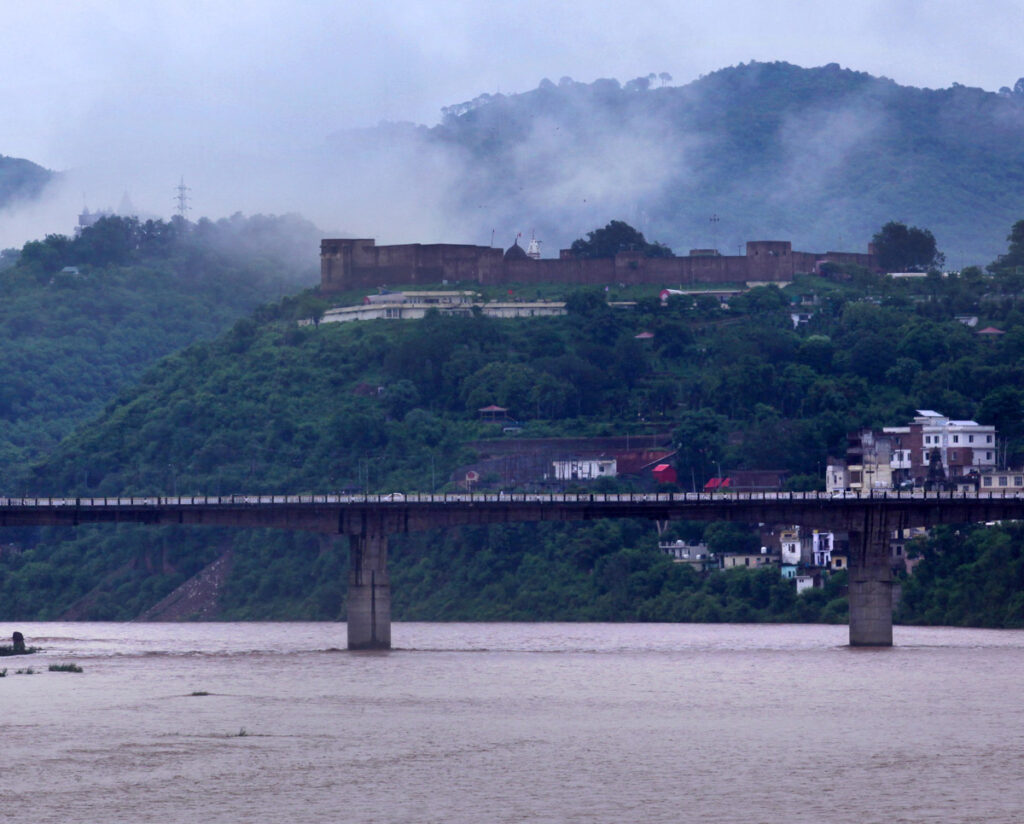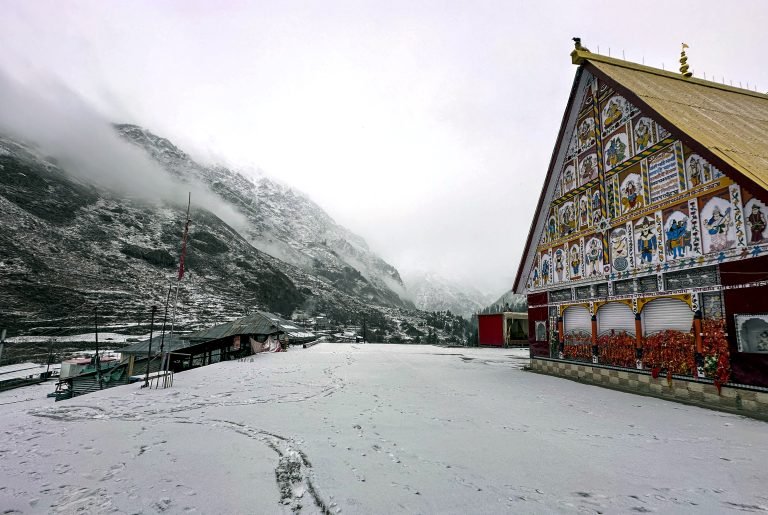Nestled atop a hill overlooking the serene Tawi River, the historic Bahu Fort houses the revered shrine of Goddess Kali, locally known as Bawe Wali Mata. This iconic temple in Jammu is a cornerstone of faith, history, and tradition, attracting countless devotees and tourists alike. With its unique blend of spiritual significance and architectural beauty, the Bawe Wali Mata Jammu temple stands as a testament to Jammu’s rich cultural heritage. The people of Jammu regard Bawe Wali Mata as the city’s guardian deity and attribute the city’s safety and prosperity to her divine grace.
The Spiritual Ambiance of Bawe Wali Mata Shrine
Before dawn, the tranquil surroundings of the shrine come alive with the sounds of conch shells, bell chimes, and the enchanting recitation of Vedic hymns. The daily Aarti (a special prayer) fills the air with divine vibrations, offering a sense of peace and spiritual connection to everyone nearby.
As the day progresses, the temple sees a steady influx of devotees, particularly on auspicious days such as Tuesdays, Sundays, and during the Navratras. These occasions witness massive crowds, necessitating heightened security to ensure smooth and safe worship experiences.
Bawe Wali Mata Jammu Temple is a well-known spiritual site dedicated to Goddess Mahakali, who is seen as a powerful source of energy and strength. People believe that Bawe Wali Mata protects Jammu from harm and bad luck. Because of this strong faith, many visit the temple to pray for courage, safety, and prosperity. Locals see Bawe Wali Mata as a constant presence in their lives, bringing comfort, healing, and answers to their prayers. This bond makes the temple more than just an old structure—it becomes a powerful symbol of faith and devotion in the region.
Historical Roots of Bawe Wali Mata Jammu Temple
The Bawe Wali Mata temple boasts a fascinating history, dating back to 1350 BCE when Raja Bahu Lochan, a ruler of the solar dynasty, built the fort and established the shrine. The idol of Mahakali, revered as the primary deity, earned the shrine the title Bahu Gadh Rani (Queen of Bahu Fort).
In 1820 CE, Maharaja Gulab Singh, a Dogra ruler, witnessed a divine vision of the Goddess, inspiring him to renovate the temple. Once surrounded by dense forests, the temple now sits amidst urban settlements, a transformation that displaced local wildlife, particularly monkeys, who now frequent the temple complex.
Read also: Amazing things you should know about Historical Bahu Fort
Legend and History of Kali Mata Mandir(Bawe wali mata temple)
The temple is believed to have been built during 8th century in 1822 a little after the Maharaja Gulab Singh came to power. As per local folklore, it is believed that around 300 years ago, goddess Maha Kali appeared in Pandit Jagat Ram Sharma’s dream and spoke about her appearance in the form of a Pindi or stone buried on the hill top. Shortly after that a stone was found and a temple was built on the hill. The black stone that is symbolic of the goddess is said to have been got from Ayodhya by the kings belonging to the Solar dynasty, Raja Bahu Lochan and Raja Jambu Lochan much before the temple was constructed.
The temple was renovated so it appears to be a new temple. Animal sacrifice was widely practiced in the past, but nowadays temple priest perform a few rituals and sprinkles holy water over a sheep or goat before setting it free as a symbolic rendition of the sacrifice. This ritual is known as Shilly Charana. Devotees offer a sweet pudding known as Kadah to the goddess after their wishes have been fulfilled by her. Bahu fair is organised in Kali mata temple twice a year during navratras each in month of march-april and September-october. The temple attracts devotees in large number. A special puja is also performed here twice a week each on Tuesday and Sunday.
Cultural Significance and Traditions
The Bawe Wali Mata shrine is deeply embedded in Jammu’s cultural fabric. A common practice among locals is bowing their heads in reverence while crossing the Tawi Bridge, a symbolic gesture of respect for the deity. This act is a cherished tradition and reflects the spiritual connection between the shrine and the people of Jammu.
A prominent feature of the temple complex is a red sandstone pond with stairs leading into the water. While its original purpose remains debated, some believe it was used by nearby residents for water collection. The intricate sandstone work adds to the fort’s historical and architectural charm.
Legends and Miracles of Bawe Wali Mata
The shrine’s significance is accentuated by numerous legends and miraculous tales. One of the most famous stories dates back to the 1965 Indo-Pak war. As enemy planes approached Jammu to bomb the Tawi Bridge, the pilots reportedly encountered a mysterious darkness and saw a divine figure—a little girl in a red dress holding a lit lamp—warding them off. Such tales of divine intervention are immortalized in Dogri folk songs and local traditions.

Top Attractions to See in Bawe Wali Mata Jammu Temple
The central dome which houses the main temple dedicated to Goddess Kali.
The temple premises are home to a big group of Rhesus monkeys, supposed to be the largest group in Jammu and Kashmir. Cameras, sunglasses, food, hats should be kept away from their sight as they are notorious for snatching away such things from visitors.
Musical fountain show or water show at the Bagh-e-bahu, a beautiful and popular garden.
Bagh-e-Bahu Aquarium is an India’s largest underground aquarium. It is home to 400 different species of fish.
Visit Bagh-e-Bahu Park, where its unique location offers stunning views of the Tawi River and the scenic beauty of Jammu
Read also: Best Shopping Places in Jammu City
Festivals and Celebrations Bawe Wali Mata Jammu
The temple witnesses grand celebrations during Navratras, when the shrine opens at 4 AM and remains accessible until 10 PM, except for a brief afternoon closure. During these days, special Langars (community kitchens) are organized, offering food to devotees, while vendors set up stalls selling fasting-friendly delicacies and traditional offerings like Chunri (scarves), flowers, and garlands.
Other significant rituals include Jatars (pilgrimages) and Chowkis (night-long devotional events). Devotees often bring offerings to fulfill vows or participate in Kanjak Pujan, a ritual honoring young girls as embodiments of the Goddess.
Some Important Customs and Activities:
Offering of Prasad: People make various sweet, flower, fruit, and coconut offerings to priests, who then offer them in the goddess’s favor before distributing them as prasad, or sacred food.
Mannat Tradition: Thousands of devotees throng the temple to make a mannat (promise) during Navratri- making some promise or giving something in return of getting their desires fulfilled. After satisfaction, they return to the temple and pay a visit.
Jagrans (Night Vigils): Devotees hold jagrans, night vigils. They sing hymns and bhajans for the goddess as they keep awake throughout the night. This helps in building a deep spiritual ambiance.
Special poojas: Special poojas are performed on the eighth and ninth day of Navratri, also known as ashtami and navami. Most people fast during this period and end their fasting after the rituals are over.
Bhandara: Devotees offer Bhandara at Bawe Wali Mata Jammu Temple to seek the blessings of Goddess Mahakali, hoping for comfort, healing, and answers to their prayers.
Architectural and Religious Features
The temple’s main entrance, a grand wooden door called Deodi, leads to the sanctum sanctorum, where the idol of Goddess Kali resides. The idol, adorned with exquisite jewelry, precious stones, and colorful attire, exudes divine splendor. A massive copper bell near the shrine adds to the sacred ambiance, as devotees ring it before seeking the Goddess’s blessings.

Surrounding the main shrine are several smaller temples, some dating back decades and others built more recently. The nearby Bagh-e-Bahu Park offers a panoramic view of Jammu city, making it a favored spot for visitors.
Read also: KNOW THE HISTORY OF THE OLDEST TEMPLE – BAWE VALI MATA
Temple Administration and Rituals
The daily rituals and worship at the Bawe Wali Mata shrine are conducted by Baridars (hereditary priests). Three priests serve at the main temple at any given time, while eight others manage adjoining shrines. This lineage of priests traces back to Pandit Neelkanth Khajuria, who established a legacy of devotion and service during Maharaja Pratap Singh’s rule.
Although there are occasional calls for a shrine board to oversee development, the Archaeological Survey of India (ASI) currently manages the temple, preserving its heritage while ensuring necessary facilities for devotees.
Visiting Time of Bawe Wali Mata Jammu
- Timings:
- Navratras: 4 AM to 10 PM (closed 2–3 PM)
- Sundays & Tuesdays: 5 AM to 9 PM
- Other Days: 6 AM to 8 PM (closed 1–2 PM)
- Best to visit during the morning and evening aarti
- Special Days: The temple sees an influx of devotees on Tuesdays, Sundays, and during Navratras, with transportation and accommodations arranged to cater to pilgrims from nearby villages and distant regions.
- Prohibitions: Leather items are not allowed inside the temple premises. Security checks ensure adherence to this rule.
- Facilities: Outside the temple, a small market offers Prasad (sacred offerings), traditional items, and refreshments for visitors.
Road Map To Bawe Wali Mata Jammu
How to Reach Bawe Wali Mata Jammu Temple
Location:
Gorkha Nagar, Jammu, Jammu and Kashmir 180006. Built inside Bahu fort which is located in Jammu region of Jammu and Kashmir state.
Best Time to Visit :
March or April and September or October in Festival time.
Nearest Railway Station :
Jammu Tawi, The temple is located at a distance of about 5.5 km from the railway station.
Nearest Air Port :
Jammu Airport, which is around 13.5 km away from the temple.
Photography:
Not allowed any Camera, Mobile inside the temple.
The Bawe Wali Mata temple is more than a spiritual site; it is a symbol of Jammu’s rich heritage and unwavering faith. From its historical roots to its vibrant traditions, the shrine offers a unique blend of culture, devotion, and architectural splendor. Whether you seek divine blessings, historical insights, or cultural experiences, a visit to Bawe Wali Mata temple promises an unforgettable journey into the heart of Jammu’s spiritual legacy.
















